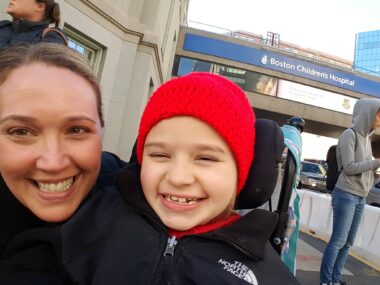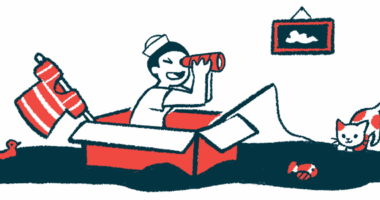A Rett syndrome clinical trial was our way of paying it forward
We owed it to our daughter and all Rett families to contribute to research

While raising a child with profound special needs, I felt like we didn’t have control over much. Rett syndrome grabbed ahold of our late daughter Cammy, and there wasn’t much we could do about it. The only things we felt we could control were raising awareness, fundraising, and assisting with further research. Participating in a clinical trial to further research was probably the hardest for me physically, mentally, and emotionally. Still, it was one of my proudest memories with Cammy, who tragically passed away on Dec. 13, 2023, at the age of 14.
Over the course of about a decade, we raised over $1.5 million for the International Rett Syndrome Foundation in Cammy’s honor. For more than 10 years, I felt it was my job to spread Rett syndrome awareness. Cammy’s Facebook page has since grown to over 23,000 followers. I am so proud of our family for the money and awareness we’ve raised.
Sacrifices for other families like ours
In 2013, Cammy, who was 4 years old at the time, participated in the first human clinical trial for Rett syndrome. This trial, focused on recombinant human IGF-1, was facilitated by Boston Children’s Hospital. When we learned that Cammy was a candidate, there was little discussion; we were committed to doing whatever it took to make it work. We felt it was our responsibility to participate, recognizing that not every family has the financial capacity or support to spend extended periods in another state. We believed we owed it to Cammy and to all the families affected by Rett syndrome to contribute to research.

Jackie, Cammy, and Bill Babiarz attend a Boston Bruins hockey game during one of their trips to the city for a clinical trial. (Photo by Jacqueline Babiarz)
Participating in the clinical trial meant we were responsible for our own travel, lodging, meals, and everything in between. Our trial required six trips from Chicago to Boston. We drove for the longer trips, which lasted seven to 10 days, and flew for the shorter ones that took two days for data collection. I accompanied Cammy on all six trips, while my husband, younger daughter, sisters, and their kids joined us for some of the longer visits. In total, Cammy and I spent 65 days in Boston over the course of a year and a half.
During our first trip, we stayed for 10 days, during which Cammy underwent daily tests, including X-rays for scoliosis, bone density checks, and electrocardiograms. She also underwent Mullen Scales of Early Learning assessments, blood tests, and completed numerous questionnaires. At the end of this initial phase, we were given a logbook and 20 weeks’ worth of twice-daily injections, but we didn’t know whether she received the IGF-1 drug or a placebo. We returned home and continued giving Cammy her shots.
By week 10, we flew back to Boston for a couple of days of testing. After the 20 weeks were completed, we drove back for another week to go through the same tests that were conducted during our initial visit. That concluded the first round of the trial.
Following a washout period of several months, where we returned to our everyday life without shots or logging details, we prepared for another long trip to undergo the same procedures as the first round. We were eager to determine which round included the placebo and which included the drug.
Cammy handled everything like a champion; she never flinched or cried during the injections and never fussed during the tests. I believe she understood she was a pioneer, doing something remarkable for families like ours.

Jackie and Cammy Babiarz take a selfie outside of Boston Children’s Hospital during a clinical trial. (Photo by Jacqueline Babiarz)
Throughout our time there, we met incredible people who treated Cammy like royalty. The researchers, clinicians, hotel staff, and even strangers were wonderful. Locals provided us with suggestions for activities during our downtime. We enjoyed various experiences, from attending a Red Sox baseball game at Fenway Park to a Bruins hockey game, and we even received a personal call from hockey legend Bobby Orr after he heard Cammy’s story. She was also invited to a Dropkick Murphys concert and attended the after-party.
Since we stayed at the same hotel for each visit, we formed a close bond with the staff. They would prepare a mini Christmas tree and decorations in our room for our arrival, and open the restaurant early so Cammy could have breakfast before her testing. The shuttle driver often made special trips for us, like taking Cammy and me to drop off laundry or to Mike’s Pastry, ensuring I didn’t have to navigate transportation on my own with Cammy and her wheelchair.
Traveling with Cammy was always stressful, whether by car or plane. Extended hotel stays were challenging, and being away from home was tough. However, knowing we were making a difference gave us a sense of control. I would encourage anyone with the means to participate in a clinical trial to do so. The experience taught me a lot about the process, helped me meet incredible people, and revealed just how strong we are.
Note: Rett Syndrome News is strictly a news and information website about the disease. It does not provide medical advice, diagnosis, or treatment. This content is not intended to be a substitute for professional medical advice, diagnosis, or treatment. Always seek the advice of your physician or other qualified health provider with any questions you may have regarding a medical condition. Never disregard professional medical advice or delay in seeking it because of something you have read on this website. The opinions expressed in this column are not those of Rett Syndrome News or its parent company, Bionews, and are intended to spark discussion about issues pertaining to Rett syndrome.








Leave a comment
Fill in the required fields to post. Your email address will not be published.